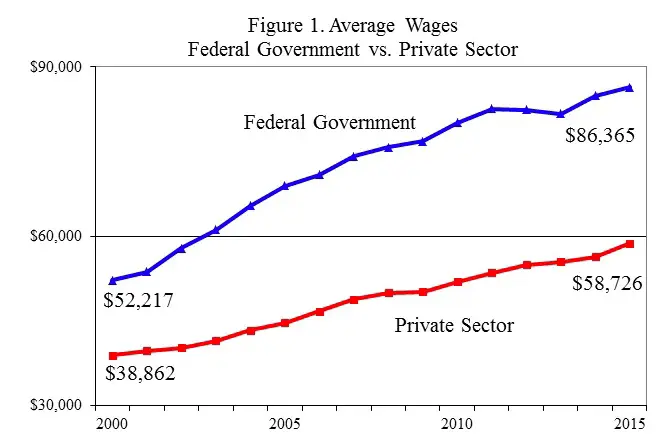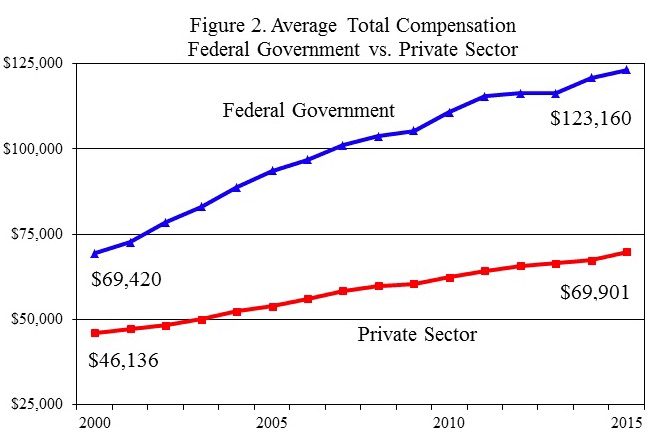Chris Edwards is the director of tax policy studies at the Cato Institute and he is the editor of Downsizingovernment.org. His latest analysis of total federal employee compensation has just been published.
His analysis is based on data from the Bureau of Economic Analysis—an agency within the Department of Commerce. He also addresses arguments frequently raised by federal employee advocates for raising pay and benefits.
Growing Differential in Federal Employee Compensation Package and Private Sector
The article cites two major trends. There is a growing differential between federal pay and benefits and private sector pay and benefits going back a number of years. The differential temporarily slowed as a result of a partial pay freeze for federal employees. It is now growing larger again.
These charts are reprinted with permission:
Adding in benefits including health care and pensions, the advantage of federal employees over private workers gets larger. In 2015, total federal compensation averaged $123,160 or 76 percent more than the private-sector average of $69,901, as shown in the figure below.
We Are Not Burger Flippers
One argument used in justifying higher federal employee compensation packages is reflected in a comment from a reader using the name “Common Sense”: “These ‘studies’ are so bogus. Question: how many burger flipper (sic) work for the government?”
In other words, the federal government has better educated and more specialized employee skills than private sector companies.
Among the 21 major industries in the U.S., the federal employees are among the highest paid. Employees in utilities, mining, and management of companies are ahead of the federal workforce. The other sectors are compensated less.
The latest BEA data indicate federal compensation is higher, on average, than compensation in the information industry, finance and insurance, and professional and scientific industries. Also, Edwards writes:
[T]he federal workforce has always had a heavy contingent of skilled professionals, such as lawyers. So that factor does not seem to explain why federal compensation has grown faster than private-sector compensation in recent decades. Average federal compensation was 39 percent higher than average private compensation in 1990.” That federal pay advantage jumped to 50 percent by 2000, and then to 76 percent by 2015.
Comparing Benefit Packages
In 2015, according to Edwards’ analysis of BEA data, the value of benefits in federal employee compensation averaged $36,795. The average benefit package in the private sector was $11,175. According to Edwards, “That large difference stems from more federal workers receiving certain types of benefits than private workers, and from particular federal benefits being more generous than those provided in the private sector.”
Job Security
The article cites another benefit of working for Uncle Sam. Federal employees are infrequently fired. 0.5% of federal employees are fired in a year, including for poor performance and misconduct. That is one-sixth of the private-sector firing rate.
For the senior executive service, the firing rate is 0.1 percent. By comparison, about two percent of corporate CEOs are fired each year.
The “quit rate” of federal employees, often cited as a reason by the president for not approving a larger federal pay raise, is one-fourth the rate of private sector employees.





